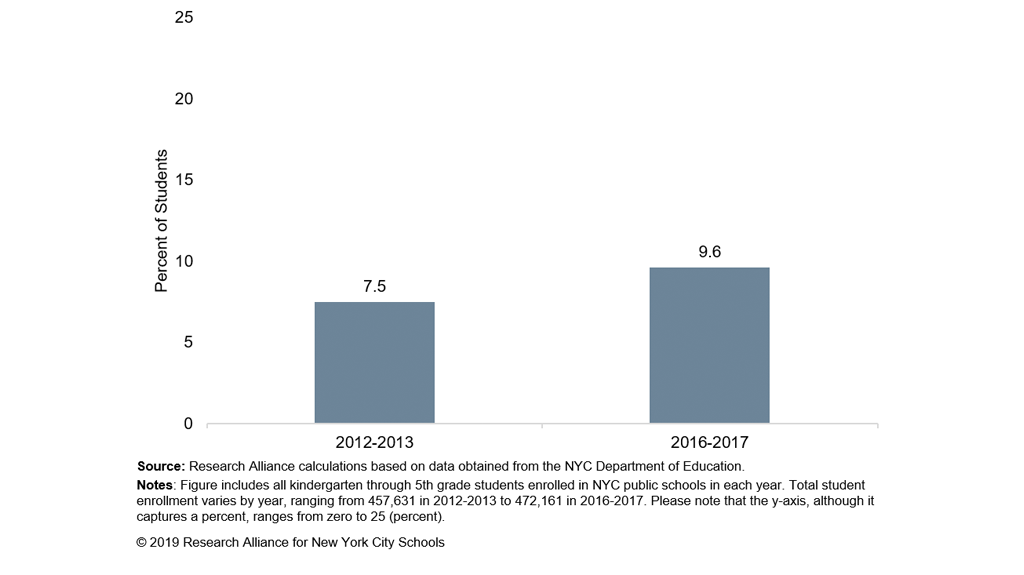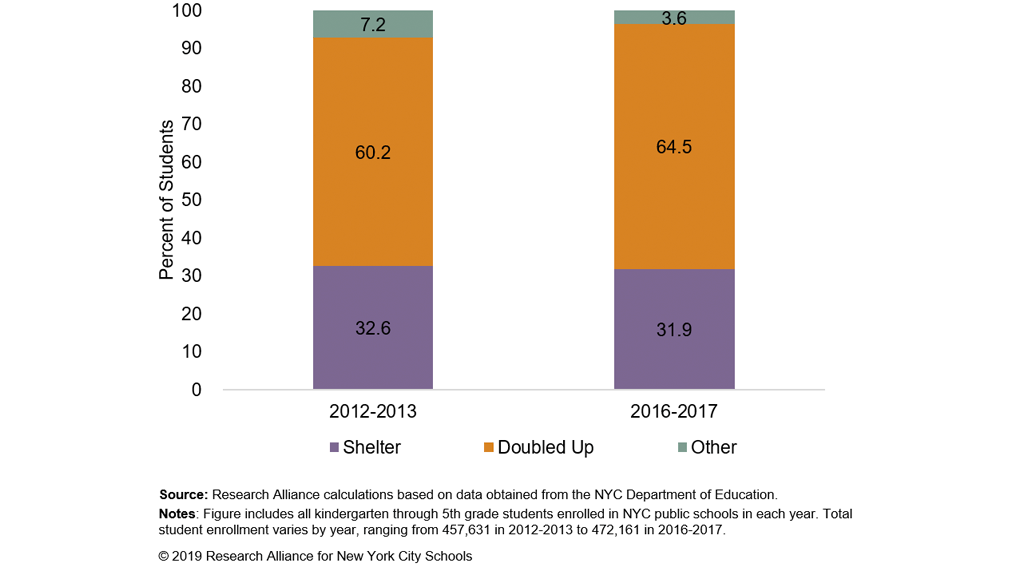Increasing numbers of children in New York City are experiencing homelessness. As we show in Figure 1, almost one in ten elementary school-aged children—or more than 45,000 students—experienced homelessness in 2016-2017, up from 7.5 percent (or just over 34,000 students) five years earlier.
Figure 1: How Has the Prevalence of Homelessness Among Elementary School-Aged Students Changed?

These numbers don’t tell us much, however, about the ways in which students experience homelessness—and how that has changed in recent years. Homeless students in NYC include students who are:
- Doubled up with another family or person because of housing loss or economic hardship;
- Living in an emergency or transitional shelter; or
- Experiencing other forms of homelessness, such as staying in a facility while awaiting foster care placement, or living in hotels or even cars, tents, or the street.
Figure 2 below shows the proportion of homeless students—during the 2012-2013 and 2016-2017 school years—broken up into the three groups based on the type of homelessness they experienced. In this five-year period, we find relatively little change in the proportion of students living in shelters: this group constituted about a third of all homeless students in both 2012-2013 and 2016-2017. In contrast, we see that the proportion of students who are doubling up increases, from 60 to 65 percent of all homeless students. Given the size of the NYC school system, this means that there are about 8,600 additional students who are doubled up in 2016-2017 relative to five years earlier. Relatedly, the proportion of students who experience other forms of homelessness is halved in this period, with 3.6 percent of students living in hotels, public spaces, or awaiting foster care placements in 2016-2017 compared to 7.2 percent five years earlier.
Figure 2: How Has the Type of Homelessness Experienced by Elementary School-Aged Students Changed?

In general, homeless students have worse outcomes than students who remain permanently housed. Our recent study highlighted that students who live in shelters are particularly vulnerable. For example, more than three quarters of students living in shelters were chronically absent, compared with a little under half of students who were doubled up, and just over 30 percent of those who were permanently housed. Similarly, students in shelters had much lower rates of proficiency on state tests than other students.
Having more fine-grained information about how students experience homelessness—beyond the shelter versus doubled up distinction—might help schools provide more targeted and effective support. For instance, it would be useful to know how students become homeless, the duration of their housing instability, and how far they are traveling to get to and from school.
Yet school staff report that gathering this kind of information—and sharing it when students change schools (which happens more often for homeless youth)—is challenging. This raises a number of important questions for district leaders, educators, and researchers:
Big Questions:
- As other scholars have shown, becoming homeless is often a process or a sequence of events. How can school data systems be improved, so they capture the fluidity of students’ housing circumstances?
- Do many families experience being doubled up prior to moving into shelters—and might this highlight an opportunity to intervene and prevent families from entering the shelter system? Or are the shelter and doubled-up populations largely separate?
- Why do academic experiences and outcomes vary for students who experience homelessness in different ways? What routines and practices can schools employ to support students experiencing different types of homelessness and housing instability?
What else should we be asking about students experiencing homelessness? Let us know via email.
This post was authored by Zitsi Mirakhur and Kathryn Hill.
How to Cite this Spotlight
Mirakhur, Z., Hill, K. 2019. "How Do Elementary-Aged Students in New York City Experience Homelessness?" Spotlight on NYC Schools. Research Alliance for New York City Schools.

